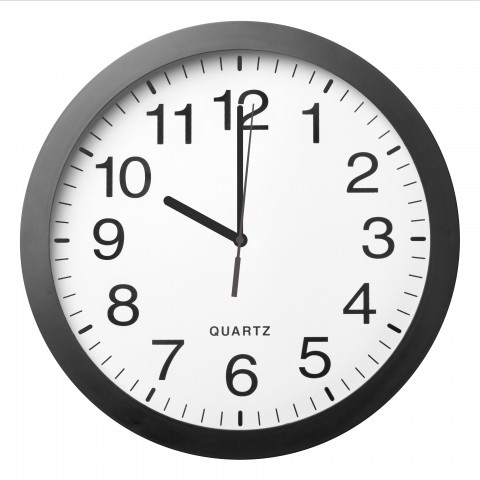
Telling time is part of everyday life, and it’s one of the essential conversation skills you need to learn when studying a new language. Want to learn how to tell time in Cantonese? No worries—we’ve got you covered! But before we start learning about telling time in Cantonese, let’s go over how to ask for the time and other time-related questions.
 Table of Contents
Table of Contents
- How to Ask for the Time
- How to Tell Time in Cantonese
- Words that Refer to the Time of the Day
- Time Adverbs
- Bonus: Time Proverbs and Sayings
- Conclusion: How CantoneseClass101.com Can Help You Learn More Cantonese
1. How to Ask for the Time

1- 而家幾點呀?
Meaning: What time is it?
Romanization: ji4 gaa1 gei2 dim2 aa3
Format: Spoken Cantonese
Notes: The phrase 幾點 (gei2 dim2) literally means “How many hours?” In conversational Cantonese, it’s common to add the word 而家 (ji4 gaa1), meaning “now,” at the beginning of the sentence. Note that the actual Cantonese noun for “time” is 時間 (si4 gaan1) and 幾點呀 (gei2 dim2 aa3) actually equates to “when” in English. So if someone invited you to an event and you’d like to know when it’ll be, just ask 幾點呀 (gei2 dim2 aa3).
2. How to Tell Time in Cantonese

The method we use for telling the time in Cantonese is very similar to how a clock works. We use numbers in Cantonese that correspond to the numbers on an hour- and minute-hand clock.
1- Hours
The numbers one to twelve are used primarily when we talk about hours. To say what time it is (in hours), we add the number (1 – 12) to 點 (dim2): 十點 (sap6 dim2).
十 (sap6) is “10” in Cantonese, so 十點 (sap6 dim2) is essentially ten o’clock. The only exception is two o’clock, where we use 兩 (loeng5) instead of 二 (ji6).
- 1 o’clock: 一點 (jat1 dim2)
- 2 o’clock: 兩點 (loeng5 dim2)
- 3 o’clock: 三點 (saam1 dim2)
- 4 o’clock: 四點 (sei3 dim2)
- 5 o’clock: 五點 (ng5 dim2)
- 6 o’clock: 六點 (luk6 dim2)
- 7 o’clock: 七點 (cat1 dim2)
- 8 o’clock: 八點 (baat3 dim2)
- 9 o’clock: 九點 (gau2 dim2)
- 10 o’clock: 十點 (sap6 dim2)
- 11 o’clock: 十一點 (sap6 jat1 dim2)
- 12 o’clock: 十二點 (sap6 ji6 dim2)
Example Sentence: 而家十二點。
Meaning: It’s now 12 o’clock.
Romanization: ji4 gaa1 sap6 ji6 dim2
Format: Spoken Cantonese
2- Minutes
Telling the time in Hong Kong is easy: you’re always running late. The rule of thumb is to say the hour plus 點 (dim2), as explained in the section above, followed by the number of minutes past the hour.
Like the United States, Hong Kong follows a twelve-hour cycle in which the time repeats itself in both the morning and afternoon.
Structure
To express both hours and minutes, say the hour first as mentioned in the section above, then add the number (1 to 59) to 分 (fan1). Note that for 1 through 9, we’ll add “0” in front of the number; for example, 2:02 is 兩點零二分 (loeng5 dim2 ling4 ji6 fan1).
- 1:05: 一點零五分 (jat1 dim2 ling4 ng5 fan1)
- 2:12: 兩點十二分 (loeng5 dim2 sap6 ji6 fan1)
- 3:15: 三點十五分 (saam1 dim2 sap6 ng5 fan1)
- 4:28: 四點二十八分 (sei3 dim2 ji6 sap6 baat3 fan1)
- 5:30: 五點三十分 (ng5 dim2 saam1 sap6 fan1)
- 6:33: 六點三十三分 (luk6 dim2 saam1 sap6 saam1 fan1)
- 7:37: 七點三十七分 (cat1 dim2 saam1 sap6 cat1 fan1)
- 8:44: 八點四十四分 (baat3 dim2 sei3 sap6 sei3 fan1)
- 9:46: 九點四十六分 (gau2 dim2 sei3 sap6 luk6 fan1)
- 10:50: 十點五十分 (sap6 dim2 ng5 sap6 fan1)
- 11:51: 十一點五十一分 (sap6 jat1 dim2 ng5 sap6 jat1 fan1)
- 12:59: 十二點五十九分 (sap6 ji6 dim2 ng5 sap6 gau2 fan1)
Example Sentence: 而家係七點三十七分。
Meaning: It’s now 7:37.
Romanization: ji4 gaa1 hai3 cat1 dim2 saam1 sap6 cat1 fan1
Format: Spoken Cantonese
Quarters
There are alternative ways to express quarters (e.g. the :15-, :30-, and :45-minute marks) in Cantonese.
In addition to the structure introduced above, you can also use 三 (saam1) to replace 十五分 (sap6 ng5 fan1) for “:15”; 半 (bun3) to replace 三十分 (saam1 sap6 fan1) for “:30,” and 九 (gau2) to replace 四十五分 (sei3 sap6 ng5 fan1) for “:45.”
- 10:15 : 十點三 (sap6 dim2 saam1)
- 5:30 : 五點半 (ng5 dim2 bun3)
- 6:45 : 六點九 (luk6 dim2 gau2)
Example Sentence: 而家係十點三。
Meaning: It’s now 10:15.
Romanization: ji4 gaa1 hai6 sap6 dim2 saam1
Format: Spoken Cantonese
Note that the actual word for “minute” in Cantonese is 分鐘 (fan1 zung1).
3. Words that Refer to the Time of the Day

1- 上晝
Meaning: a.m. / morning
Romanization: soeng6 zau3
Format: Spoken Cantonese
Example
- Sentence / Phrase: 上晝六點
- Romanization: soeng6 zau3 luk6 dim2
- Meaning: 6 o’clock a.m.
2- 下晝
Meaning: p.m. / afternoon
Romanization: haa6 zau3
Format: Spoken Cantonese
Example:
- Sentence / Phrase: 下晝十一點
- Romanization: haa6 zau3 sap6 jat1 dim2
- Meaning: 11 p.m.
3- 晏晝
Meaning: noon
Romanization: aan3 zau3
Format: Spoken Cantonese
Example:
- Sentence / Phrase: 晏晝十二點
- Romanization: aan3 zau3 sap6 ji6 dim2
- Meaning: 12:00 noon
4- 早上
Meaning: morning
Romanization: zou2 soeng6
Format: Written Cantonese
Example:
- Sentence / Phrase: 我在早上緩步跑。
- Romanization: ngo5 zoi6 zou2 soeng6 wun4 bou6 paau2
- Meaning: I jog in the morning.
5- 晚上
Meaning: evening
Romanization: maan5 soeng6
Format: Written Cantonese
Example:
- Sentence / Phrase: 我白天勤力工作,所以晚上放鬆。
- Romanization: ngo5 baak6 tin1 kan4 lik6 gung1 zok3, so2 ji5 maan5 soeng6 fong3 sung1
- Meaning: I work hard during the day, so I relax in the evening.
6- 白天
Meaning: daytime
Romanization: baak6 tin1
Format: Written Cantonese
Example:
- Sentence / Phrase: 我白天勤力工作,所以晚上放鬆。
- Romanization: ngo5 baak6 tin1 kan4 lik6 gung1 zok3, so2 ji5 maan5 soeng6 fong3 sung1
- Meaning: I work hard during the day, so I relax in the evening.
7- 夜晚
Meaning: nighttime
Romanization: je6 maan5
Format: Spoken Cantonese
Example:
- Sentence / Phrase: 已經到夜晚。
- Romanization: ji5 ging1 dou3 je6 maan5
- Meaning: It’s already nighttime.
4. Time Adverbs

1- 同時
Meaning: meanwhile
Romanization: tung4 si4
Format: Spoken Cantonese
Example:
- Sentence / Phrase: 我同時睇緊電視。
- Romanization: ngo5 tung4 si4 tai2 gan2 din6 si6
- Meaning: Meanwhile, I am watching TV.
2- 而家
Meaning: right now
Romanization: ji4 gaa1
Format: Spoken Cantonese
Example:
- Sentence / Phrase: 而家係十二點五十九分。
- Romanization: ji4 gaa1 hai3 sap6 ji6 dim2 ng5 sap6 gau2 fan1
- Meaning: It’s now 12:59.
3- 之前
Meaning: before
Romanization: zi1 cin4
Format: Spoken Cantonese
Example:
- Sentence / Phrase: 之前係我錯。
- Romanization: zi1 cin4 hai6 ngo5 co3
- Meaning: I was wrong (before).
- Note: As there’s no past tense for verbs in Cantonese, we use 之前 (zi1 cin4) to indicate an action that happened in the past.
4- 之後
Meaning: after / later
Romanization: zi1 hau6
Format: Spoken Cantonese
Example:
- Sentence / Phrase: 你話之後會搵我。
- Romanization: nei5 waa6 zi1 hau6 wui5 wan2 ngo5
- Meaning: You promised you will find me later.
5- 就嚟
Meaning: soon
Romanization: zau6 lai4
Format: Spoken Cantonese
Example:
- Sentence / Phrase: 我就嚟到。
- Romanization: ngo5 zau6 lai4 dou3
- Meaning: I will be arriving soon.
6- 就快
Meaning: almost
Romanization: zau6 faai3
Format: Spoken Cantonese
Example:
- Sentence / Phrase: 就快有十年歷史。
- Romanization: zau6 faai3 jau5 sap6 nin4 lik6 si2
- Meaning: It’s almost ten years old.
7- 夠鐘
Meaning: It’s time
Romanization: gau3 zung1
Format: Spoken Cantonese
Example:
- Sentence / Phrase: 夠鐘,停筆。
- Romanization: gau3 zung1, ting4 bat1.
- Meaning: It’s time, pens down.
8- 好耐
Meaning: a long time
Romanization: hou2 noi6
Format: Spoken Cantonese
Example:
- Sentence / Phrase: 好耐冇見。
- Romanization: hou2 noi6 mou5 gin3
- Meaning: It’s been a long time since we last met.
9- 一早
Meaning: earlier on
Romanization: jat1 zou2
Format: Spoken Cantonese
Example:
- Sentence / Phrase: 我一早就同你講唔得。
- Romanization: ngo5 jat1 zou2 zau6 tung4 nei5 gong2 m4 dak1
- Meaning: I told you earlier on that it wouldn’t work.
10- 盡快
Meaning: as soon as possible
Romanization: zeon6 faai3
Format: Spoken Cantonese
Example:
- Sentence / Phrase: 你盡快嚟。
- Romanization: nei5 zeon6 faai3 lai4
- Meaning: Please come as soon as possible.
5. Bonus: Time Proverbs and Sayings

1- 好久不見
Meaning: Long time no see.
Romanization: hou2 gau2 bat1 gin3
Format: Written Cantonese
2- 時間就係金錢
Meaning: Time is money.
Romanization: si4 gaan3 zau6 hai6 gam1 cin4
Format: Spoken Cantonese
3- 光陰如箭
Meaning: Time flies.
Romanization: gwong1 jam1 jyu4 zin3
Format: Spoken / Written Cantonese
4- 寸金難買寸光陰
Meaning: An inch of gold will not buy an inch of time.
Romanization: cyun3 gam1 naan4 maai5 cyun3 gwong1 jam1
Format: Spoken / Written Cantonese
5- 時間可以治療一切
Meaning: Time heals all wounds.
Romanization: si4 gaan3 ho2 ji5 zi6 liu4 jat1 cit3
Format: Spoken / Written Cantonese
Do you want to learn how to tell dates as well? Check out our article on dates here!
6. Conclusion: How CantoneseClass101.com Can Help You Learn More Cantonese

Learning how to tell time is important—but it’s equally crucial to cherish your time and spend it wisely. If your goal is to better your Cantonese, we do advise you to invest your time in CantoneseClass101.com!
With CantoneseClass101.com, you can have your daily dose of Cantonese whenever and wherever you want, through mobile apps, desktop software, and our website. We offer entertaining, engaging, and effective lessons on various aspects of the Cantonese language and culture.
Until now, we’ve delivered more than 750,000,000 lessons to thousands of happy students from all around the globe. You can learn Cantonese with over 1060 audio and video lessons delivered by our knowledgeable and energetic hosts, detailed PDF lesson notes, an abundance of vocabulary learning tools, spaced repetition flashcards, and a lively community to discuss the lessons with fellow learners. What are you waiting for? Download our lessons, enjoy our audio and video files, and start learning now!
And keep in mind that if you prefer a one-on-one learning approach and want to further accelerate your Cantonese learning, you can take advantage of our MyTeacher program!
Know that your hard work will pay off, and before you know it, you’ll be speaking Cantonese like a native!
Before you go, let us know in the comments what time it is where you are, in Cantonese! It’ll be good practice. 😉 We look forward to hearing from you!










